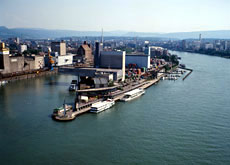Basel’s shipping industry turns 100

This year the shipping industry in the northern Swiss city of Basel is celebrating its 100th anniversary.
But even though the amount of goods transported on the River Rhine is increasing, shipping enjoys little recognition among the public.
On June 2, 1904, the screw steamer, “Knipscheer IX”, docked in St Johann port after a ten-day journey along the Rhine.
It was towing the barge, “Christina”, loaded with 300 tons of coal for the city’s gasworks, and their historic arrival proved that big ships could sail as far as Basel.
Up until then it was thought that bulk cargoes could not reach the city – the place where the Rhine turns north.
The current in the upper Rhine was relatively strong at the time because there were no locks or dams to slow the river.
Strong current
But since the arrival of the first big ships a hundred years ago, shipping cargo in Basel has grown continuously.
“The development of the ports, jobs and safety on the river or on the ships themselves is amazing,” Heinz Merzweiler, the president of Basel’s shipping museum, told swissinfo.
The port proved a lifeline for the country during the Second World War, enabling landlocked – and neutral – Switzerland to get vital supplies.
Today around nine million tons of cargo, which accounts for about 15 per cent of total Swiss exports, is processed through Basel’s four ports every year. However, the ports have the capacity to deal with twice as many goods.
Shipping between Rotterdam and the four ports in Basel carries the equivalent of 80 per cent of the goods transported by the Swiss Federal Railways.
“There have been efforts to extend transport all the way up to Lake Constance,” Rudolf Feierabend, president of the Swiss Shipping Association (SSA), told swissinfo.
Swiss exports
Today a typical Rhine barge is 135 metres long and has space for 450 shipping containers. It takes around 90 hours for a powered barge to travel to Basel from the nearest seaport.
The quays of the four ports have a total length of seven kilometres, and more than 1,700 people are employed in shipping.
“People don’t recognise the importance of Rhine shipping,” said Feierabend.
“This may be due to the fact that Rhine shipping is the only important mode of transport that is not subsidised by the government.”
The centenary is giving Basel the opportunity to correct this and make the public aware of shipping’s importance to the city.
Various events are being held including a festival and seminars on transport, logistics and ecology.
swissinfo, Alexander Künzle in Basel
Nine million tons of cargo is processed through Basel’s ports.
It takes 90 hours for a barge to reach Basel from the nearest port.
Around 1,700 people are employed in shipping.

In compliance with the JTI standards
More: SWI swissinfo.ch certified by the Journalism Trust Initiative
You can find an overview of ongoing debates with our journalists here. Please join us!
If you want to start a conversation about a topic raised in this article or want to report factual errors, email us at english@swissinfo.ch.